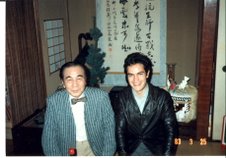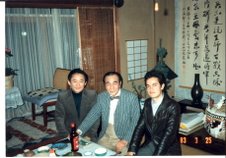Comment: Hot 3 at Nybrokajen 11
This is a report from my room in Hotel Adlon, Stockholm. What a glorious city this is; I have spent many hours walking its streets, admiring its majestic design and its relaxed, grown-up urban ecology, where people seem to know how to function with efficiency in a laid-back, relatively stress-free environment.
The concert at Nybrokajen 11 was, in fact, not just by the two talented musicians I listed in a previous posting, but by Hot 3, a trio made up of said two talents plus violist Torbjörn Helander. The line-up, then, is flute, guitar and viola. The full programme was as follows:
Anders Hultqvist: Rain and After, Composition No. 6
Klaus Huber: Ein Hauch von Unzeit
Agustín Fernández: A to Z
Madeleine Isaksson: Fibres
Rebecca Saunders: Molly’s Song #3
José Manuel López López: Trio n:r II
Before the concert, also in the grand setting of Nybrokajen 11, there was an introductory talk hosted by Goran Bergendal, a doyen of new music in Stockholm and former senior producer at Rikskonserter. He interviewed Stefan Östersjö (the guitarrist in Hot 3 and the man responsible for commissioning A to Z), Madeleine Isaksson and myself on topics relevant to the night’s programme. The talk was in Swedish but mercifully Goran switched to English when my slot began.
The venue is blessed with very good acoustics, even though this was not in the main hall but in the café. I didn’t count the seats but there must have been about sixty, of which probably fifty of fifty-five were occupied. This didn't do much to allay my misgivings about the size of new music audiences, but I won’t launch into that discussion here. Those who were there seemed a committed bunch, except, perhaps, for the young man sitting next to me, who before long began to nod off, gradually progressing from nodding to dozing until my piece began, which is when dozing became deep slumber. When, at the end of A to Z, I walked up to the front to take a bow, on returning to my seat I found the young had gone. Nor did he come back for the second half. Embarrassment? Or annoyance at finding that he was at the wrong event? We’ll never know.
The musicians played a very challenging programme with much panache and commitment. All the pieces were demanding each in its own way, and I was taken aback by the scale A to Z has taken on now that it has nine movements plus several transitional passages added to smooth over some of the instrument changes. The duration is at least twenty-two minutes and the energy expenditure is high and unrelenting throughout. Even the slower pieces, ‘Última nana’ and ‘Danza oscura’, have a tension that seemed to take a lot out of the players. What first came to life as a collection of little études is now a tour de force, and the études, if they can still be called that, are, in technical challenge if not in size, transcendental along the lines of Liszt’s or Ligeti’s piano études. But Östersjö and Thiwång delivered them with aplomb and virtuosity.
Of the rest of the programme I was particularly impressed by Isaksson’s Fibres, a delicate exploration of instrumental colour thoughtfully organised in a coherent structure of clear harmonic steps, and Saunders’s Molly’s Song #3, which displayed a searching approach to sonic possibilities well before the radio receivers and the music box were switched on.




1 comment:
So well and nice posting , I like it.
Bathmate
Post a Comment